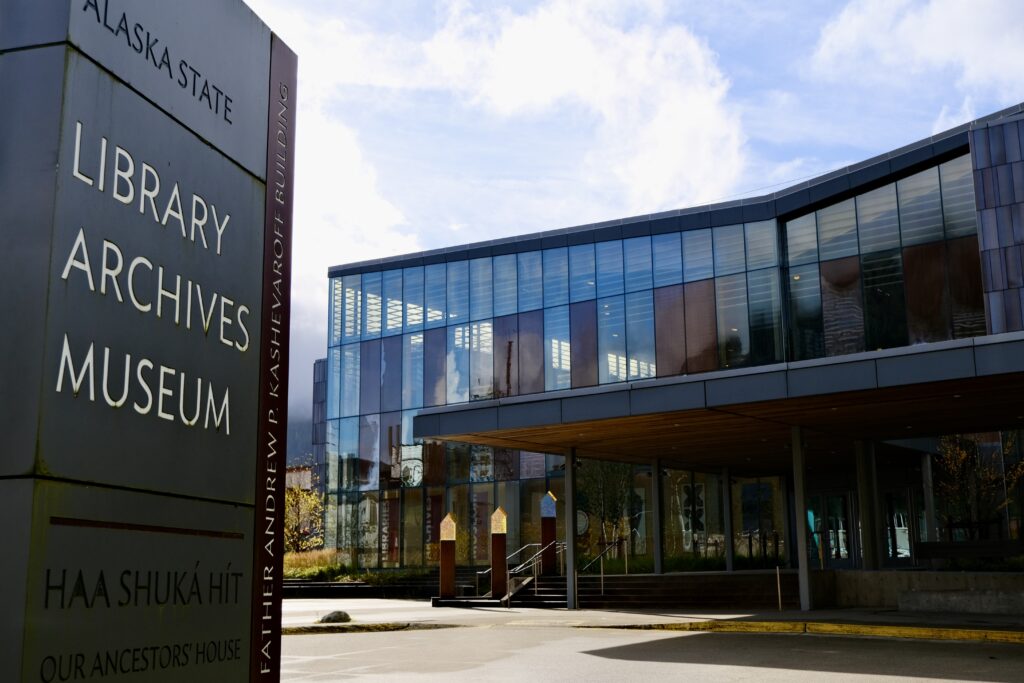Juneau’s Alaska State Museum is seen in the fall sun on Oct. 2, 2024. (Photo by Claire Stremple/Alaska Beacon)
Sarah Knudsen has been beading for long enough that she says she can recognize where the artist is from in Alaska just by looking at their beadwork.
“Gwich’in Athabascan beadwork is mostly flowers and stems. In the Southeast, the motif of their culture is that they have more Eagles and their clans. We don’t have plans up here,” she said.
Her grandmother taught her in the Gwich’in Athabascan tradition on the Porcupine River, beading on felt and tanned moose hide. That knowledge eventually led her to seek a grant aimed at welcoming Alaska Native artists and culture bearers in to the state’s museums, which allowed her to travel from her home in Fort Yukon, 8 miles north of the Arctic Circle, to the Alaska State Museum in Juneau in March.
There, she researched beaded moccasin styles and saw firsthand the changes in moccasin patterns, beadwork and materials since the early 1800s.
Knudson already had a background doing academic research on Athabascan trade routes and applied that knowledge to her study of different moccasin styles and materials from around the state, which she shared with museum researchers and curators.
“I learned a lot, and we really had a good time exchanging information, and I would recommend it to anyone,” she said.
The Access to Alaska Native Collections grant is offered by Museum Alaska, a nonprofit that formed out of the Alaska Historical Society, and it allows Alaska Native artists and culture bearers to access museums and collections across the state. The program will give away at least $18,000 with funding from the Cook Inlet Region, Inc, an Alaska Native regional corporation. The grant program has funded the travel of 17 artists since its inception last year.
It is part of a broader movement aimed at fostering Alaska Native cultural heritage and artistic sovereignty.
While countless Alaska Native belongings, art pieces and sacred objects are housed in Alaska’s state museums, the institutions have not always fostered strong bonds with the Indigenous community and many Alaska Native art works and objects were taken and displayed in museums without permission.
The grant recognizes that history and the need for improved relationships and is aimed at outreach to welcome Alaska Native artists into museum spaces.
Dixie Clough, Museum Alaska’s director, said the ultimate goal is to break down barriers and increase awareness that museums are open to everyone and exist for people to come in and experience what they have to offer.
“It’s so expensive to travel in Alaska, and so that’s a huge barrier for artists, especially rural artists, to be able to visit these museums,” Clough said.
Past grantees like Knudson have traveled to museums statewide, including the State Museum and the Sealaska Heritage Institute in Juneau, the Anchorage Museum, the University of Alaska Fairbanks Museum of the North, Ketchikan Museums, the Haines Sheldon Museum and the Cordova Historical Museum.
Clough said that museums are doing work to grapple with their roots in fields like anthropology and archaeology that have Eurocentric, colonial histories, and this grant is a form of outreach.
“For some people in Indigenous cultures, museum is almost a bad word, and it’s totally understandable why,” Clough said.
She said that after going through the first rounds of distributing grants, the feedback from museums and Alaska Native artists and culture bearers has been positive.
“The museums really enjoyed meeting new artists and building those connections that maybe will lead to more connections. And artists, just — there’s so many Alaska Native collection items in museums that are so important to continuing their cultures. So there’s a lot of inspiration that happened on the artist side,” she said.
The grant is one piece of a broader movement called the Alaska Native Museum Sovereignty initiative whose goal is to increase opportunities for museums to work with Alaska Native people by providing access to collections and opportunities to build exhibits with them. Nadia Jackinsky-Sethi, a Ninilchik tribal member based in Homer, helped conceive the effort while she worked for Cook Inlet Region Inc. and said she is inspired by what the grant does for the state.
“This program allows artists to have the opportunity to get the professional development and experience with researching collections, and then museums get the opportunity to learn directly from artists, so that collections records can be updated and inclusive of Alaska Native people’s perspectives and values,” she said.
Jackinsky-Sethi said that she hopes the grant effort can grow to allow Alaska Native people to connect with cultural materials that are out of state and even out of the country in the future.
“Right now feels like an especially good time to be doing that kind of work, with the changes that are happening around repatriation,” she said, referring to a broader reckoning among museums that some materials in their collections were taken from communities without consent.
“This project is just a great way to help Alaska Native people have the opportunity to reconnect with historical materials in an intimate and meaningful way,” she said.
GET THE MORNING HEADLINES.

